
A platformer is a sub-genre of action video games in which the core objective is to move the player character between points in an environment. Platform games are characterized by levels with uneven terrain and suspended platforms of varying height that require jumping and climbing to traverse. Other acrobatic maneuvers may factor into the gameplay, such as swinging from vines or grappling hooks, jumping off walls, gliding through the air, or bouncing from springboards or trampolines.
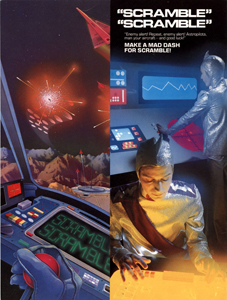
Scramble is a horizontally scrolling shooter arcade video game released in 1981. It was developed by Konami and manufactured and distributed by Leijac in Japan and Stern in North America. It was the first side-scrolling shooter with forced scrolling and multiple distinct levels, and it established the foundation for a new genre.

Bio-ship Paladin, known in Japan as Space Battleship Gomora, is a 1990 horizontally scrolling shoot 'em up arcade game released by UPL and distributed by Sammy Corporation for North American manufacture. It was later ported to the Sega Mega Drive. While the game is essentially a standard horizontally scrolling shoot 'em up, it has an innovation that makes it unique in the genre. The player flies a spaceship which has the standard forward guns to be found in all horizontal scrollers, but it also possesses a weapon that can be manually targeted with a crosshair, in the same manner as in the game Missile Command. This allows the player to fire in any direction with pinpoint accuracy, and adds an extra level of strategy to the game. The game saw an almost arcade perfect port on the Mega Drive, albeit with a few changes that actually enhanced the look of the game such as added parallax scrolling backgrounds in the second level. It would eventually see a worldwide re-release as part of the Arcade Archives series for Nintendo Switch and PlayStation 4 on August 5, 2021.
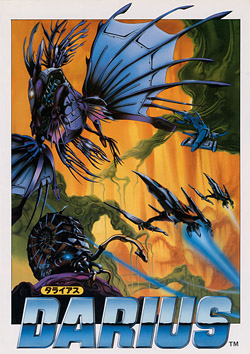
Darius is a 1987 horizontal-scrolling shooter arcade game developed and published by Taito. Players control a starship named the Silver Hawk in its mission to destroy the Belser empire before they wipe out the planet Darius. Its gameplay involves traversing through a series of scrolling levels while destroying enemies and collecting power-up icons. It is notable for its unique three-screen panoramic display, upbeat soundtrack, and cute anime-influenced graphics.

Choplifter is a military themed scrolling shooter developed by Dan Gorlin for the Apple II and published by Broderbund in 1982. It was ported to Atari 8-bit computers the same year and also to the VIC-20, Commodore 64, Atari 5200, ColecoVision, MSX, and Thomson computers.
Fueled by the previous year's release of the colorful and appealing Pac-Man, the audience for arcade video games in 1981 became much wider. Pac-Man influenced maze games began appearing in arcades and on home systems. Pac-Man was the highest grossing video game for the second year in a row. Nintendo's Donkey Kong defined the platform game genre, while Konami's Scramble established scrolling shooters. The lesser known Jump Bug combined the two concepts into both the first scrolling platform game and the first platform shooter. Other arcade hits released in 1981 include Defender, Frogger, and the Galaxian sequel Galaga.

Banpresto Co., Ltd. was a Japanese video game developer and publisher headquartered in Shinagawa, Tokyo. It had a branch in Hong Kong named Banpresto H.K., which was headquartered in the New Territories. Banpresto was a partly-owned subsidiary of toymaker Bandai from 1989 to 2006, and a wholly-owned subsidiary of Bandai Namco Holdings from 2006 to 2008. In addition to video games, Banpresto produced toys, keyrings, apparel, and plastic models.

Captain America and the Avengers is a beat 'em up arcade game developed and released by Data East in 1991. It features the Avengers team of Marvel Comics characters in a side-scrolling brawling and shooting adventure to defeat the evil Red Skull. The game received ports for the Sega Genesis/Mega Drive, Super Nintendo Entertainment System, Game Boy and Game Gear. A different Data East game was released for the Nintendo Entertainment System.

Astron Belt (アストロンベルト) is a LaserDisc video game in the form of a third-person, space combat rail shooter, released in arcades in 1983 by Sega in Japan, and licensed to Bally Midway for release in North America. Developed in 1982, it was the first major arcade laserdisc video game. The game combines full-motion video (FMV) footage from the laserdisc with real-time 2D graphics. The arcade game was available in both upright and cockpit arcade cabinets, with the latter having illuminated buttons on the control panel, a larger 25" monitor, and a force feedback vibrating seat.
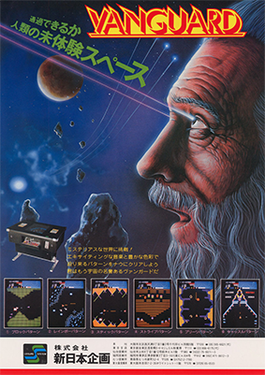
Vanguard is a scrolling shooter arcade video game developed by TOSE. It was released by SNK in Japan and Europe 1981, and licensed to Centuri for manufacture in North America in October and to Zaccaria in Italy the same year. Cinematronics converted the game to cocktail arcade cabinets in North America.

Salamander 2 is a 1996 horizontally scrolling shooter arcade video game developed and published in Japan by Konami. It is the direct sequel to Salamander (1986) and the third game in the Salamander series, which itself is a spin-off of the Gradius franchise. Up to two players control two starships — the Vic Viper and the Super Cobra — as they must destroy the alien race Doom before they wipe out all of the planet Gradius. Gameplay involves shooting down enemies, collecting power-up items, and avoiding collision with projectiles or obstacles.
A side-scrolling video game is a game viewed from a side-view camera angle where the screen follows the player as they move left or right. The jump from single-screen or flip-screen graphics to scrolling graphics during the golden age of arcade games was a pivotal leap in game design, comparable to the move to 3D graphics during the fifth generation.
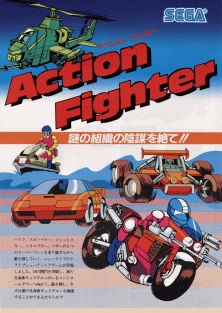
Action Fighter is an overhead vehicular combat game released by Sega for arcades in 1986. It was ported to the Master System the same year, and then to the Amiga, Amstrad CPC, Atari ST, Commodore 64, ZX Spectrum and IBM PC compatible computers.
Up'n Down is an arcade video game developed by Sega and released in 1983. It was ported to the Atari 2600, ColecoVision, Atari 8-bit computers, and Commodore 64. In Up'n Down, the player drives a car forward and backward along a branching, vertically scrolling track, collecting flags and jumping on other cars to destroy them.
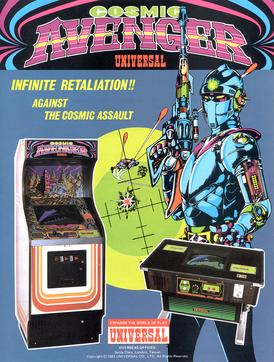
Cosmic Avenger is a scrolling shooter developed by Universal and released as an arcade video game in July 1981. It is part of the first wave shooters with forced horizontal scrolling which followed Konami's Scramble and Super Cobra from earlier in the year. It was released the same month as Vanguard. The final installment in Universal's Cosmic series, players take control of the Avenger space fighter and, as in Scramble, use bullets and bombs against enemy air and ground forces. The world is one continuous level made up of different areas.

Borderline is a vertically scrolling shooter maze game released by Sega as an arcade video game in April 1981. The player controls a jeep and has to destroy enemy refineries. There are four stages with different gameplay. The first stage plays like a vertically scrolling shooter. In the second stage, the player maneuvers his Jeep through underbrush, and enemies can only follow on its path, a concept later found in Namco's Dig Dug (1982).

SDI - Strategic Defense Initiative, or simply titled SDI and sometimes known as Global Defense, is a 1987 horizontally scrolling shooter produced and released internationally in arcades by Sega. It was later ported to home computers and game consoles, some by other companies. Players control a satellite and must destroy enemies by moving a crosshair over them and firing the satellite's weapons.
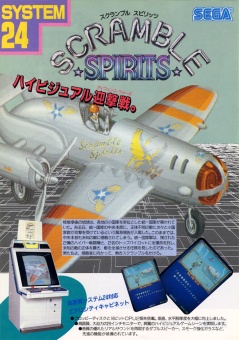
Scramble Spirits is a vertically scrolling shooter game released for the arcades by Sega in 1988. It was ported to the Master System the same year, then to personal computers in 1990.
A vertically scrolling video game or vertical scroller is a video game in which the player views the field of play principally from a top-down perspective, while the background scrolls from the top of the screen to the bottom to create the illusion that the player character is moving in the game world.

Game Tengoku: The Game Paradise! is a 1995 vertical-scrolling shooter arcade game developed and published by Jaleco. The game is a parody of arcade shooters in a vein similar to the Parodius series. It was followed up with a sequel, Gun Bare! Game Tengoku 2.
















